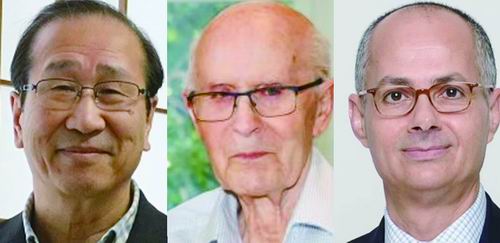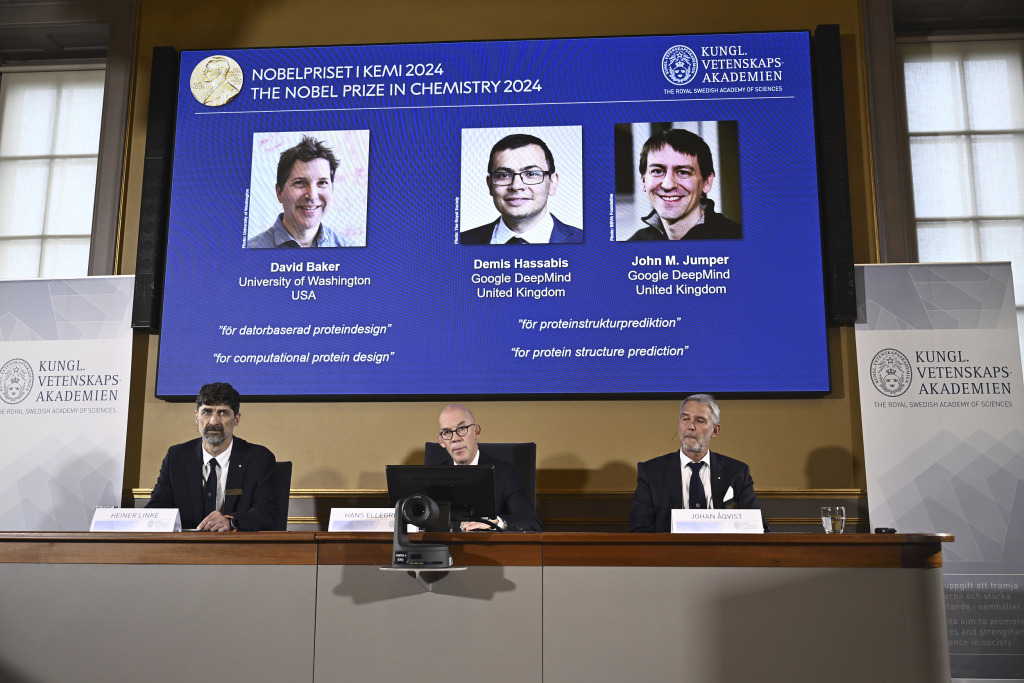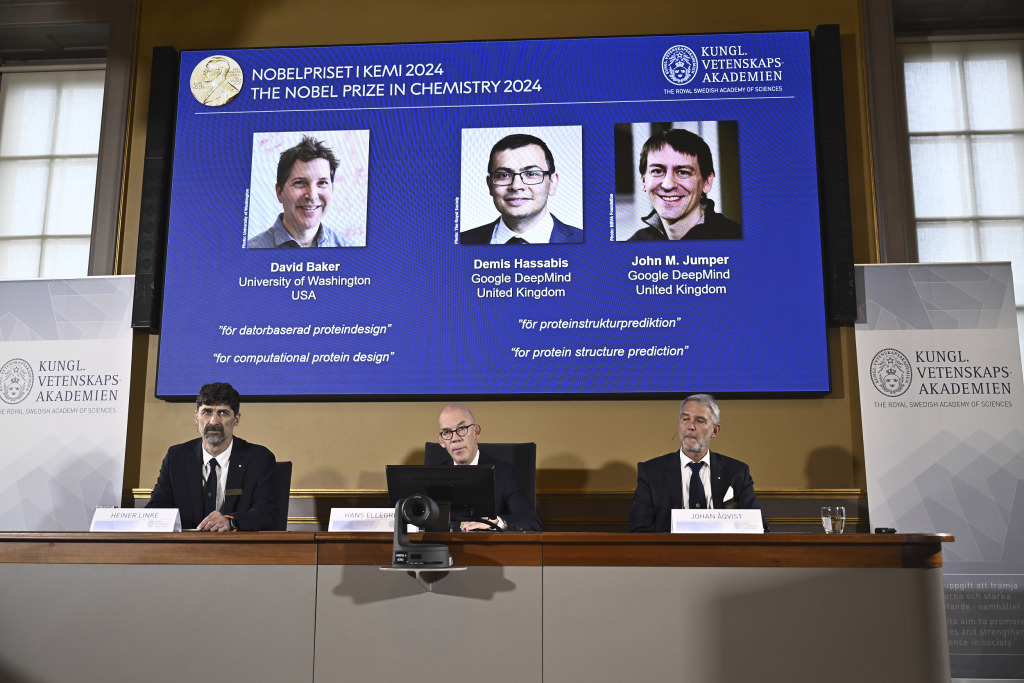

Susumu Kitagawa (left), Richard Robson (center) and Omar Yagi.
The 2025 Nobel Prize in Chemistry was announced at approximately 5:45 p.m. Beijing time on October 8. Japanese scientist Susumu Kitagawa, Australian scientist Richard Robson, and American scientist Omar M. Yaghi were awarded the prize for their development of metal-organic frameworks (MOFs).
Heiner Link, chairman of the Nobel Prize in Chemistry Committee, said that MOFs have enormous potential and bring previously unimaginable opportunities for customizing materials with new functions.
"Congratulations to Professor Omar Yaghi! The University of California, Berkeley can finally give him a special parking space for the Nobel Prize!" That night, Lin Shixian, a researcher at the Institute of Life Sciences of Zhejiang University, said with a smile in the ScienceNet live broadcast room.
It's worth noting that Yaghi didn't begin his studies at a prestigious university, but rather at a community college. Through his extraordinary perseverance and wisdom, he ultimately won the Nobel Prize. This year marks the 30th anniversary of his introduction of the concept of "grid chemistry," exemplified by MOFs.
Building blocks in the microscopic world
China Science Daily: How do you feel about the three scientists winning this year's Nobel Prize in Chemistry?
Li Qiaowei, Professor of Chemistry at Fudan University : I was Professor Yaji's doctoral student, studying in his group from 2004 to 2010. This year marks the 30th anniversary of his pioneering of the field of "grid chemistry" represented by MOFs.
I think this year's Nobel Prize in Chemistry is well deserved by these three professors.
Susumu Kitagawa is a renowned scholar in the field of MOFs. His contribution is to elevating the concept of "coordination polymers" to "porous coordination polymers." He was the first to demonstrate, through high-pressure gas adsorption experiments, that these materials possess pores that allow molecules to enter, a first step in proving their porosity.
Robson's most important contribution was introducing the fundamental geometric principles of "vertices and edges" in crystal chemistry into the study of framework materials. This gave the frameworks a "design sense," allowing us to predict and construct target topologies by selecting specific "vertices" and "edges," providing important theoretical guidance for the early development of MOFs.
Lin Shixian : When I learned that Yaji had won the Nobel Prize, I was very excited! When I was studying at the University of California, Berkeley, my colleagues and I discussed when he would win the Nobel Prize and when the Berkeley campus would provide him with more parking spaces.
Berkeley's campus is located on a hillside, with limited space and on-campus parking. As a sign of respect, the university allows Nobel laureates to drive directly onto campus. Other faculty and students must park in off-campus parking lots and walk up the hill to campus. This small perk has become a popular topic on campus.
Dong Jinqiao, Tenured Associate Professor at Shanghai Jiao Tong University : The three laureates have proposed a novel material construction method, leveraging the self-assembly process of metal ions and organic ligands to create crystalline porous materials with highly controllable structures. This material system combines the stability of inorganic materials with the designability of organic materials, breaking through the limitations of traditional materials in structural control and functional realization, and opening up a new paradigm in porous materials research.
China Science Daily: How to understand the concept of MOF in a simple way?
Professor Zhang Yi from the School of Chemistry and Chemical Engineering at Central South University stated : "The first MOF material in the broadest sense was a very stable dye called Prussian Blue. However, the problem is that such extremely stable framework materials often lack the catalytic activity we require." We can imagine the construction of MOFs as a microscopic "building blocks": a metal ion serves as the core, surrounded by various organic ligands connected by coordination bonds, thus building a diverse and diverse framework structure.
Jiang Xuefeng, Professor of the School of Chemistry and Molecular Engineering at East China Normal University , said: "In the chemical industry, we imitate nature by using organic ligands to coordinate metals, creating cages, frameworks, regular tetrahedrons, and other structures like Lego." These are MOFs. Essentially, MOFs are "confinement tools" in chemistry. "Confinement" means confining molecules to specific areas. This allows them to behave differently from macroscopic systems in terms of electronic transitions, orbital configurations, and catalytic properties, thus introducing many new principles.
Existing commercial applications
China Science Daily: What is the application value and prospects of MOF?
Dong Jinqiao : MOF materials exhibit tremendous application potential due to their adjustable pore structure and highly ordered crystal arrangement. For example, in the field of gas adsorption, MOFs can be used to selectively adsorb target molecules such as nitrogen and carbon dioxide from industrial coal gas, demonstrating excellent separation and purification performance. In the field of catalysis, immobilizing organic catalysts within the pore structure of MOFs not only achieves stereoselectivity and confinement effects, but also effectively prevents catalyst deactivation, significantly improving catalytic efficiency and increasing the number of recycles, thereby reducing production costs.
Currently, some MOF materials have achieved initial commercial application, showing promising prospects in gas storage and separation, particularly in gas storage and separation. It is foreseeable that with the further development of related technologies and the continuous optimization of costs, MOF materials will be widely used in more industries, unleashing their enormous potential in key areas such as energy, environment, and medicine. We expect MOFs to become a major force driving the transformation of new materials.
Lin Shixian : MOF materials have been widely studied in universities and research institutions. I believe that the awarding of the Nobel Prize will greatly stimulate enthusiasm for commercial transformation and find innovative applications for this framework material that will change human life and health.
Jiang Xuefeng : MOFs, with their porous structure, show broad application prospects in gas separation, detection, catalysis, and drug release. However, their "building block" cage structure is prone to collapse in complex industrial environments, and stability remains a major bottleneck for industrialization. This Nobel Prize not only recognizes the contributions of the three founders, but also reflects people's hope for the development of more stable, cheaper, and more adaptable MOF materials. MOF materials are expected to find even more applications in the future.
China Science Daily: How should we view the application potential of MOF in hydrogen storage?
Li Qiaowei : About 20 years ago, the idea of using MOFs for hydrogen storage was proposed. Research has shown that MOFs can store significant amounts of hydrogen under low temperatures and high pressures. Today, the amount of hydrogen that can be stored is increasing, and the required conditions, such as temperatures, are becoming closer to room temperature, and commercialization is slowly approaching. I am optimistic about the potential of MOFs combined with the advantages of other materials for hydrogen storage.
China Science Daily: Does winning a Nobel Prize in a field mean it has reached its peak? What impact will this have on the field's future development?
Zhang Yi : I don't think so. We can use supramolecular chemistry as an analogy. It won its first Nobel Prize in 1987 and again in 2016. The Nobel Prize isn't a destination, but rather a milestone, signaling the field's maturity and immense potential. It inspires more talent and resources to flow in, propelling it to new heights. Ultimately, however, this depends on future breakthroughs in practical applications.
Dong Jinqiao : The aura of the Nobel Prize will further stimulate the global scientific community's attention and investment in this field, accelerating the transformation of MOFs from structural construction to functional applications. In fact, the Nobel Prize is often not the end of a research direction, but a new starting point.
“A hero’s origins are not judged”
China Science Daily: Judging from this year's Nobel Prize winner in Chemistry, what do you think is the "Tao" for a scientist to succeed?
Li Qiaowei : Yaghi was born in Jordan and began his education at a community college in the United States. He then earned his undergraduate degree at the State University of New York and his doctorate from the University of Illinois at Urbana-Champaign (UIUC). A visionary, he conceived the concept of framework chemistry at an early age and, with keen insight, plunged into the field of porous materials. He strongly supported student innovation, and his pioneering research on covalent organic frameworks (COFs) began by allowing students free rein for exploration, which he later nurtured into a significant direction.
Zhang Yi : Persistence is crucial, especially when you're unsure of the outcome or even feel lost. This award deeply reminds me of the saying, "A hero's origins are not judged by his or her accomplishments." On the one hand, researchers should not limit themselves due to their humble beginnings. On the other hand, I suggest that universities and research institutions should not place too much emphasis on a researcher's primary degree or background. What truly matters is their scientific insight, creativity, and persistent effort.
Jiang Xuefeng : If I had to sum it up in one word, I think it would be "fun." Scientists often start out with a certain utilitarian purpose—they're driven by a desire to solve a specific problem. But once they delve deeper, they need to let go of that utilitarianism and return to curiosity and passion. MOFs have a myriad of structural variations, from Chinese knots to circular rings to square cages. Building them is inherently fun.
In scientific exploration, most attempts may not always pan out, but it is through constant trial and error that we approach the unknown and solve real problems. We should encourage young people to choose science for its "fun," allowing them to understand the laws of nature and overcome their fear of the unknown through exploration, thereby contributing to their personal growth and social development through their knowledge. For scientists and technologists, the ultimate goal is to create "useful" things through fun, and to use "useful" things to solve human problems.
Lin Shixian : My biggest impression of MOF's success is the beauty of simplicity—the material's synthesis path is incredibly simple, its chemical structure embodies the beauty of simplicity, and the scientists' approach to research is also very simple. As the saying goes, "the greatest virtue is simplicity," perhaps every researcher should consider how to achieve simpler science.
China Science Daily: What kind of scientist is Yaji?
Li Qiaowei : During my six years of study, my research was largely driven by my interests. He didn't specify a specific application goal. This allowed us to work based on our curiosity. My results in the first three or four years weren't particularly impressive, but I didn't feel the pressure to publish. This allowed me to delve deeper into my research with a better mindset.
After graduation, we maintained a good teacher-student relationship. I often invited him to give lectures at Fudan University, and we would keep in touch with each other on research progress. He was an admirable teacher who truly placed scientific research at the highest level.
Zhou Zihui, a postdoctoral fellow at the University of California, Berkeley, said: "I'm Professor Yaji's doctoral student and currently conducting postdoctoral research in his group. He meticulously cares about his students, whether they're freshmen or graduates about to start their careers. If we need a one-on-one discussion with him, we can usually get a meeting within a week by sending him an email."
Whenever he was in school, he would spend the whole day in the lab, from 8 a.m. to 4 p.m.
Lin Shixian : Yaji's story is legendary and deeply moving. I heard he immigrated to the United States at the age of 15 and learned English from scratch. He exemplifies a powerful example of a scientist who reshapes his destiny through dedicated research and pursuit of his scientific aspirations. Later, I learned that his childhood experience of water scarcity led him to pursue his passion for developing MOF materials that extract water from the air. He integrated his personal dreams into his research, demonstrating the profound humanistic value behind science.


